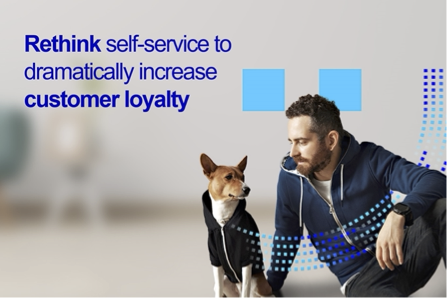We have all been there. Chatting online with a bot that talks in circles and sends you to a webpage that is the opposite of helpful. Or on the other end of a lousy phone call with a bot, repeating information to an algorithm and screaming for an agent. This kind of "service" is the quickest way to lose loyal customers.
In a recent report from NICE, most customers will abandon a brand after two negative customer service experiences. And your customers are begging for something better: 81% of customers want more self-service options, according to the same report. So how can you focus your CX investment priorities on giving your customer the smart self-service experience they crave?
Truly intelligent self-service enables the fastest resolution when it is data-driven and utilizes conversational AI that feels effortless, friendly, and more human. For the best results, look for AI that is purpose-built for customer experience. Because it is purpose-built, the best AI for CX uncovers and acts on customer needs and customer intents by analyzing every customer interaction, regardless of device or channel, to deliver personalized and proactive service across the entire customer journey from start to finish.
Let’s break down those elements needed for genuinely smart self-service.
Turbocharge CX with AI
Customers want fast, convenient digital self-service, which will require effectively harnessing conversational AI, data, and analytics. A scalable, AI-powered next-gen CX cloud platform like CXone, can help you deliver on the promise of smart self-service: better CX, improved operational efficiency, lower costs, higher revenue, and more.
Unlike typical hand-scripted bots with limited recognition and accuracy, AI-engineered self-service results in high success rates and reduces significant volume handled by human agents by “listening” and scripting those same bots with the actual hundreds of simple needs customers have and the ways they express them. In turn, this creates new opportunities for sales, service, and support roles to offload repetitive tasks and instead focus on higher-value projects with more rewarding work.
This saves businesses significant time and effort by eliminating manual development and hand coding—the most costly and onerous part—which shrinks “time to deploy” from months to days. Companies can create more effective virtual agents capable of full resolution because they have been trained on real human conversations.
Knowledgeable virtual agents ensure that customers are understood, and the self-service experience flows like a human conversation. The result is higher success rates (aka “containment”) and reduced volume handled by human agents. Not to mention a dramatically improved automated experience for customers.
Hyper-personalize interactions through data analytics
While traditional self-service often relies on a narrative approach to finding opportunities for automation—a brainstorm, for example, of customer needs and how self-service could be used to solve them—smart self-service takes an empirical approach by automatically harnessing experience data to make self-service smarter.
NICE’s data-driven strategy fuels the move to smarter self-service and includes different types of data. For example:
- Semantic data sheds light on the nuances of conversation and the context of questions to make it rich and meaningful.
- Episodic data enables brands to learn from past customer experiences intelligently to create more hyper-personalized connections and reshape customer conversations with self-service applications.
- Procedural data provides insight into the next best action or series of actions to achieve effective automation for customers’ needs.
Together, this data can be leveraged by AI to consider all the different scenarios and outcomes of the past and identify the best next action to take. This empirical, automated approach takes the guesswork out of self-service, increasing resolution rates and customer satisfaction.
Skyrocket customer satisfaction with proactive outreach
Today’s customers have heightened expectations for CX that goes far beyond robust reactive CX. Customers expect proactive communication to inform them of potential product/service experience issues and what steps are being taken to mitigate them. Besides potential issues, consumers value companies that provide updates and alerts that would impact their experience.
Proactive conversational AI is designed to reach customers before they start engaging with you—or, more often, reach customers who prefer not to contact you in the first place but are seeking a resolution. Proactive conversations invite customers to respond wherever they are—whether in a Google search, on YouTube, or even on your website. And the issue resolution happens there, too.
Proactive outreach programs are essential to boost CX performance and customer satisfaction. According to Aberdeen, investing in CX across the customer journey with proactive programs drives YOY improvements, including a 77% greater customer retention, 4.4x increases in customer satisfaction, and a 94% reduction in service costs.
Customers expect more from you and want fast answers—without calling your company. To elevate your brand and increase brand loyalty, help customers find exactly what they’re looking for, where, and when they need answers. Make self-service much smarter than it is today with data-driven, conversational AI, and proactive outreach that anticipates customer needs and guides customers to much more satisfying answers. They will reward you with their continuing loyalty and positive recommendations.
Ready to experience truly intelligent self-service? Our eBook “Build smart self-service fast” has the answers.










